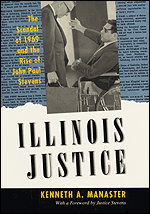Where Justice Stevens comes from

Illinois is perhaps unique for having fostered the careers of both some of the most upstanding, and of course, most corrupt political figures the nation has ever known.
This morning various papers are reporting that a member of the former camp, Supreme Court Justice John Paul Stevens, has announced his retirement. His long career in the nation’s highest court has spanned nearly four decades and seven presidencies, and though an appointee of the Ford administration, he is notable for having maintained a non-partisan and adaptable stance towards many issues from the right to choose to affirmative action. You can navigate to just about any news source for more on the final chapter in Justice Stevens’ Supreme Court career, but perhaps the more engrossing read is the story of its beginnings, embroiled the kind of dramatic struggle between darkness and light that only a city like Chicago can deliver.
Kenneth A. Manaster’s Illinois Justice: The Scandal of 1969 and the Rise of John Paul Stevens takes readers behind the scenes of one of the most spectacular Illinois political scandals (and there have been many) to tell the tale of the beginning of Stevens ascension to the high court.
In 1969, while Stevens was still a relatively unknown Chicago lawyer, citizen gadfly Sherman Skolnick accused the Illinois Chief Justice and another Illinois Supreme Court justice of accepting valuable bank stock from an influential Chicago lawyer in exchange for deciding an important case in the lawyer’s favor. The feverish media coverage that resulted—a scandalous story in its own right, as Manaster reveals—prompted the state supreme court to appoint a special commission to investigate. Within six weeks and on a shoestring budget, the commission gathered a small volunteer staff and revealed the true facts. Stevens, then a relatively unknown Chicago lawyer, served as chief counsel. His work on this investigation would launch him into the public spotlight and onto the bench.
Manaster, who served on the commission, tells the full story of the investigation, detailing the dead ends, tactics, and triumphs. At the heart of the book is the tense courtroom drama that unfolded in July 1969. Manaster expertly traces Stevens’s masterful courtroom strategies, and vividly portrays the high-profile personalities involved (almost every member of the Illinois Supreme Court took the stand), as well as the subtleties of judicial corruption. With a reflective foreword by Justice Stevens himself, Manaster’s book is both a fascinating chapter of political history and a revealing portrait of the early career of a Supreme Court justice.
See transcriptions of original source documents referenced in the book.